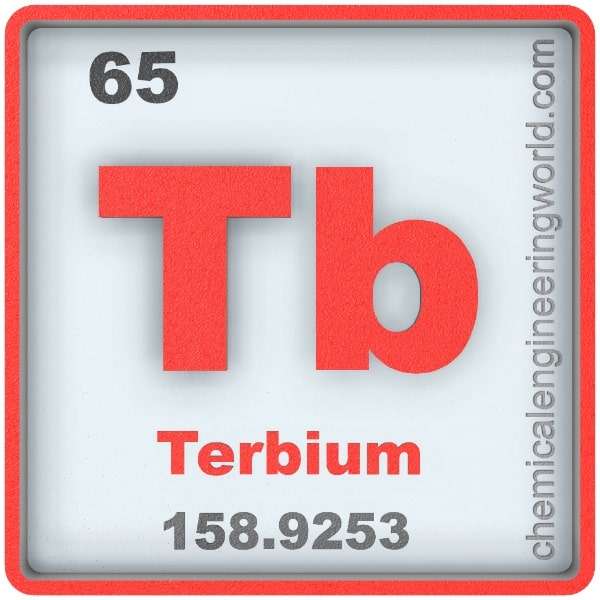Terbium Element Properties and Information

Terbium Element Properties and Information
Terbium is 65th element on the periodic table. Elements are arranged in the periodic table on the basis of the atomic number. Atomic number is the number of protons in the nucleus of the atom. Terbium has an atomic number of 65. It is located in the Group ‘Lanthanides’ and Period 6 of the periodic table of elements. It is denoted by ‘Tb’. It is named after Ytterby, Sweden.
Carl Gustav Mosander was the one who found that the extracted sample of cerium which was in the form of cerium oxide, contained more elements. He was the one who separated lanthanum from it. From his experience he reasoned that the sample of yttrium which was discovered and isolated in 1794 may also contain new elements. He investigated it and was able to obtain two new elemental oxides from it; terbium oxide and erbium oxide. He announced the discovery in 1843.
The concentration of terbium in Earth’s crust is 1.2 ppm. No terbium-dominant mineral is known as of yet, it occurs with other lanthanides and can be extracted from bastnaesite and monazite. Euxenite is a mineral which contains 1% of terbium. Terbium is never found in nature as a pure element, it is always found in combined form.
Physical Properties
- Terbium is a malleable and ductile silvery-white metal which is soft enough to be cut by a knife.
- The atomic mass of terbium is 158.92.
- The melting point of terbium is 1360°C.
- The boiling point of terbium is 3041°C.
- The density of terbium is 8300 in S.I. units at 20°C.
- Terbium exists in two crystal allotropic forms with the transition temperature being 1289°C.
- Below 219K, terbium has a simple ferromagnetic ordering. Between 219-230K, the ordering changes to helical-antiferromagnetic. Above 230K, the ordering becomes disordered paramagnetic.
- Naturally occurring terbium has only 1 stable isotope which is terbium-159. Also, 36 radioisotopes of terbium have been characterized so far.
Chemical Properties
- Terbium oxidizes readily in air to form a mixed, non-stoichiometric compound terbium(III,IV) oxide.
- Terbium reacts with water to form a hydroxide.
- Terbium reacts with halogens to form their corresponding trihalide.
- Like all lanthanides, the terbium compounds display oxidation state of +3. However, the trivalent terbium species in highly basic aqueous solution can be transformed to tetravalent terbium species by action of ozone.
- Terbium combines with carbon, nitrogen, phosphor, sulphur, boron, selenium, silicon, and arsenic, at elevated temperatures to form binary compounds.
Methods of Production
Ion-exchange & Reduction: The ore is first subjected to electrostatic separation multiple times to separate its magnetic properties. After separation it is treated with hot-concentrated sulphuric acid to get dissolved sulfates of lanthanides. The acid filter is neutralized using sodium hydroxide at pH 3-4, during this process; the thorium gets removed as a hydroxide. The solution is then treated with ammonium oxalates to get lanthanide oxalates. The oxalates are converted to oxides by annealing. The oxides are then dissolved in nitric acid solution wherein cerium gets removed because of its insolubility. The solution is then treated with magnesium nitrate to produce a crystrallized mixture of double salts of lanthanides. The salts are separated using ion exchange chromatography. During ion-exchange, the rare-earth ions are sorbed into a suitable ion-exchange resin by exchange with hydrogen, ammonium, or cupric ions present in the resin. The rare-earth ions are them selectively washed out using suitable complexing agents. The terbium metal is then produced by reducing its anhydrous chloride or fluoride with help of calcium metal.
Relevance in Chemical and Related Industries
Alloys: The terbium alloys produced mainly find applications in electronic devices.
Relevance in Other Industries
- Electronics: Terbium oxide is used in green phosphors in fluorescent lamp and colour TV tubes. Terbium is used as a dopant in calcium tungsten, calcium fluoride, strontium molybdate, etc which are used as solid-state devices.
- Detection: Terbium is used to detect endospores. Endospores are tough, dormant, and non-reproductive structure produced by some bacteria in the phylum Firmicutes.
Health Effects on Exposure
Irritant: Terbium powder and terbium compounds acts as strong irritants when they come in contact with skin and eyes.
Effects on Surroundings
- Terbium poses no threat to plants, animals, and environment.
References:
https://en.wikipedia.org/wiki/Terbium
https://www.lenntech.com/periodic/elements/tb.htm
https://www.rsc.org/periodic-table/element/65/terbium
































